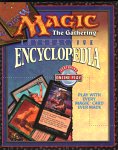 |
||||||||||||||||||||||
 |
 |
|||||||||||||||||||||
 |
 |
|||||||||||||||||||||
|
Having an Answer
I'm sure one of the reasons we all play Magic is for the feeling of human interaction. I mean, if all you wanted to do was win, you'd take up Solitare and save yourself a rather large sum of money every three or four months. Throwing the variable of your opponents into the equation is what makes the game what it is, but it also means that not only do you have to go through whatever set of operations your deck has as a means to win, you have to guard against your opponent(s) doing exactly the same thing. Unless your name is Casey McCarrel, you cannot just assume that your opponents will draw massive amounts of either land or non-land cards and remain relatively docile. You see, other players want to win too, believe it or not. They're going to play their OWN lands and cast their OWN spells and permanents. They might even try and counter your spells. They're annoying that way. That's where having answers comes in handy. An "answer card" is anything that allows you to deal with something your opponent is trying to do. When most people think of answers, they think of cards that remove permanents-- from burn to land destruction to Disenchant effects. Counterspells are also technically answers, as are cards like Tangle, but for the moment I will deal only with those cards that remove permanents from play. The most obvious place to have answer cards for any particular strategy is in one's sideboard. Post-sideboarding, it is possible to have changed out a large number of cards in one's deck and thus altered the way the deck functions in a particular matchup. But it is not advisable to have all of one's answers to permanents in the sideboard, because that leaves you at a severe disadvantage in the first game. There are no decks right now that can afford to completely ignore what their opponent is doing (Fires and Suicide Black with good draws come the closest) and doing so will very likely get you smashed flat. In order to avoid this pitfall, we must play these kinds of cards maindeck. This opens up the possibility that we will be left with dead cards in certain matchups-- Earthquake against a Blue Skies deck, for example, or Terminate versus a creatureless Millstone deck. The two deck types I cited are relatively rare in this day, but they provide a good illustration. Despite the fact that matchups exist in which those cards are theoretically almost useless, they are still excellent cards due to the fact that there are many more matchups where they are incredibly powerful. How to pick good cards with which to provide answers to your opponent's permanents? The answer is to choose versatility in most cases. Shatter and Smash are nothing you will probably see in the maindeck of a good player (assuming they don't live in a tiny pocket of artifact madness within the Magic metagame) but Pillage is much more common: it is never a dead card against any deck that plays land, which I think we agree most decks do. For this reason, Disenchant and Hull Breach are much more commonly played than any effect which destroys ONLY artifacts or ONLY enchantments; the probability that an opponent will be playing either one or the other is sufficient to warrant a main-deck slot for these cards. Creeping Mold and Befoul are yet more examples of versatile removal choices. The star of them all, of course, is Vindicate. The only situation in which it will be a dead card is one in which your opponent has no targetable permanents in play-- a situation which is probably good enough for you that you no longer need to worry. Aside from spells which simply destroy multiple classes of permanents, there are a number of ways to keep removal from sitting in your hand. Red's primary method of creature removal-- burn spells-- can also be aimed at players in most cases. (It is generally desireable to avoid playing burn spells that can only target creatures, for just this reason.) Utility spells or abilities that come attached to a permanent are also nice, as in Thrashing Wumpus, Goblin Legionaire, Uktabi Orangutan (now removed from Type 2) or Cloudchaser Eagle. It doesn't matter if there's nothing to use these creatures' special abilities on-- they beat down pretty well anyway. The last class of answer spells are those which create a global, rather than targeted, effect. Generally, these blow up all of something-- whether that something is creatures (Wrath of God), lands (Armageddon) or both of those with artifacts thrown in to boot (Jokulhaups.) The new Pernicious Deed also falls into this category. Decks which make use of these answers, also called 'reset buttons' or something similar, must make allowances for the fact that their own permanents will be affected as well. When a deck is successfully constructed that minimizes these problems, the results can be quite powerful, as in the case of Nether-Haups, a deck that could deal with just about anything via its ability to sweep the board clean of most permanents on a regular basis. With all the ways the various colors have to deal with permanents, most color combinations should be able to pack several general answers in their maindeck and a number of more specific ones in the sideboard. Deciding which ones to run and how many is something that can only be achieved through experience with a deck and its environment. -Spike
|
|||||||||||||||||||||
